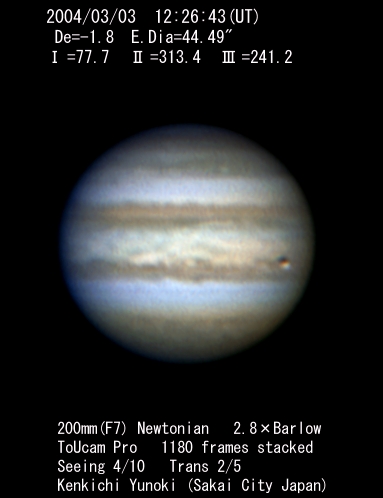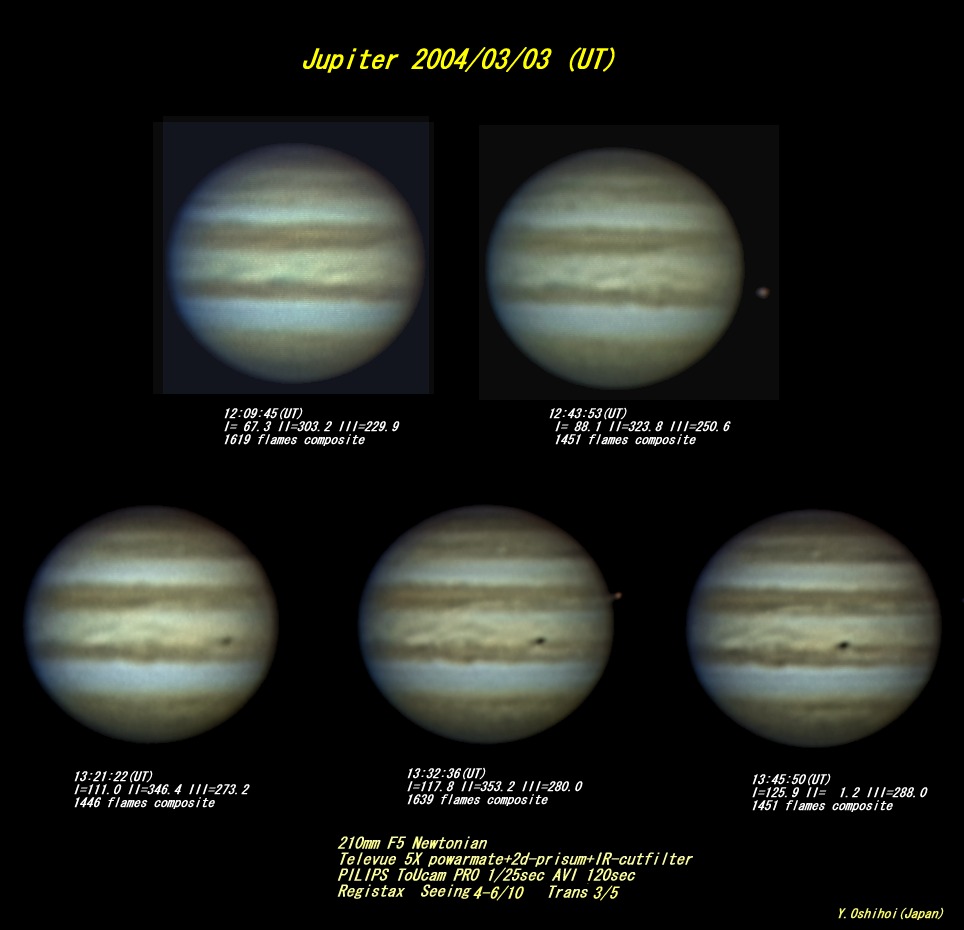|
Carlos E. Hernandez (Drawing:9-inch (23-cm) F/13.5 Maksutov- Cassegrain)
|

I made an detailed observation of Jupiter under very good (8/10) seeing conditions. I was fortunate to have experienced a break in the clouds during this observation considering our erratic South Florida weather. The view of a highly detailed Jupiter Callisto and Ganymede on either side was spectacular! I welcome any comments you may have on my observation.
Date (U.T.): March 3, 2004
Time (U.T.): 06:00
L1 201.7, L2 079.6, L3 006.2
Instrument: 9-inch (23-cm) F/13.5 Maksutov-Cassegrain
Magnification: 257x
Filters: None
Seeing (1-10): 8, Antoniadi (I-V): II
Transparency (1-6): 5
Notes:
South Polar Region (SPR): Appears dusky to dull (4-5/10) and finely mottled.
South South Temperate Zone (SSTZ): Appears bright and broad with indefinite borders.
South South Temperate Belt (SSTB): Appears as a thin, dull (5/10) band following the CM.
South Temperate Zone (STZ): Appears bright (7/10) and complex with four very bright (8/10) ovals noted within it.
South Temperate Belt (STB): Appears thin and dark (3/10) and deviating towards the south preceding the CM.
South Tropical Zone (STrZ): Appears bright (7/10) with a small, dusky (4/10) condensation over it's preceding half (very thin, dull (5/10) projections noted from it's p. and f. borders). A dusky (4/10), broad band is noted to extend from the following border of the Great Red Spot (GRS).
Great Red Spot (GRS, center at L2 090.4, L3 17.1): Appears dusky (4/10) with a dark (3/10) core and a dark (3/10) southern border. Dark (3/10) projections are noted to connect to it from the SEB.
South Equatorial Belt (SEB): Appears complex with dark (3/10) northern and southern borders interlaced with bright (7/10) regions.
Equatorial Belt (EB): Appears bright (7/10) with dusky to dull (4-5/10) condensations and bands noted within it.
North Equatorial Belt (NEB): Appears thin and dark to dusky (3-4/10). Very dark to dark (2-3/10) festoons were noted along it's southern border (NEBs). A dark (3/10) projection was noted to extend from it's southern border apparently connecting to a thin, dull (5/10) band within the NTrZ. A dark (3/10) barge (or rod) was noted along it's southern border following the CM.
North Tropical Zone (NTrZ): Appears bright (7/10) with a dark (3/10) projection extending from the NEBn connecting to a dull (5/10) band.
North Polar Region (NPR): Appears dusky to dull (4-5/10) with a dark (3/10), irregular border and fine mottling noted within.
Callisto (IV) was visible preceding the planet at the approximate latitude of the SSTB. Ganymede (III) was visible close to the following disk at the level of the STrZ (It was occulted by the planet at 06:15 U.T.).
Transit Timings:
06:15 U.T. Disappearance (occultation) of Ganymede (III)
06:18 U.T. L2 090.4, L3 017.1, Center of the Great Red Spot (GRS)
06:35 U.T. L2 100.7, L3 027.4, Following border of GRS
The best of luck to you and your family and on imaging Jupiter.
[[Carlos E. Hernandez South Florida U.S.A ]]
 ALPO-Japan Latest ALPO-Japan Latest

 Jupiter Section Jupiter Section
|






[ Donald C Parker Coral Gables, Florida U.S.A]

 ALPO-Japan Latest
ALPO-Japan Latest

 Jupiter Section
Jupiter Section